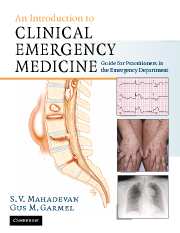Book contents
- Frontmatter
- Contents
- List of contributors
- Foreword
- Acknowledgments
- Dedication
- Section 1 Principles of Emergency Medicine
- Section 2 Primary Complaints
- 9 Abdominal pain
- 10 Abnormal behavior
- 11 Allergic reactions and anaphylactic syndromes
- 12 Altered mental status
- 13 Chest pain
- 14 Constipation
- 15 Crying and irritability
- 16 Diabetes-related emergencies
- 17 Diarrhea
- 18 Dizziness and vertigo
- 19 Ear pain, nosebleed and throat pain (ENT)
- 20 Extremity trauma
- 21 Eye pain, redness and visual loss
- 22 Fever in adults
- 23 Fever in children
- 24 Gastrointestinal bleeding
- 25 Headache
- 26 Hypertensive urgencies and emergencies
- 27 Joint pain
- 28 Low back pain
- 29 Pelvic pain
- 30 Rash
- 31 Scrotal pain
- 32 Seizures
- 33 Shortness of breath in adults
- 34 Shortness of breath in children
- 35 Syncope
- 36 Toxicologic emergencies
- 37 Urinary-related complaints
- 38 Vaginal bleeding
- 39 Vomiting
- 40 Weakness
- Section 3 Unique Issues in Emergency Medicine
- Section 4 Appendices
- Index
10 - Abnormal behavior
Published online by Cambridge University Press: 27 October 2009
- Frontmatter
- Contents
- List of contributors
- Foreword
- Acknowledgments
- Dedication
- Section 1 Principles of Emergency Medicine
- Section 2 Primary Complaints
- 9 Abdominal pain
- 10 Abnormal behavior
- 11 Allergic reactions and anaphylactic syndromes
- 12 Altered mental status
- 13 Chest pain
- 14 Constipation
- 15 Crying and irritability
- 16 Diabetes-related emergencies
- 17 Diarrhea
- 18 Dizziness and vertigo
- 19 Ear pain, nosebleed and throat pain (ENT)
- 20 Extremity trauma
- 21 Eye pain, redness and visual loss
- 22 Fever in adults
- 23 Fever in children
- 24 Gastrointestinal bleeding
- 25 Headache
- 26 Hypertensive urgencies and emergencies
- 27 Joint pain
- 28 Low back pain
- 29 Pelvic pain
- 30 Rash
- 31 Scrotal pain
- 32 Seizures
- 33 Shortness of breath in adults
- 34 Shortness of breath in children
- 35 Syncope
- 36 Toxicologic emergencies
- 37 Urinary-related complaints
- 38 Vaginal bleeding
- 39 Vomiting
- 40 Weakness
- Section 3 Unique Issues in Emergency Medicine
- Section 4 Appendices
- Index
Summary
Scope of the problem
Patients manifesting abnormal behavior are common in emergency departments (EDs). They represent one of the most challenging classes of patients the emergency physician must treat. The causes of abnormal behavior are exceedingly diverse and require physicians to maintain a high level of vigilance to determine whether an underlying medical disorder exists. In 1998, it was estimated that nearly 4% of the approximately 100.4 million ED visits in the US were for behavioral problems. Many of these patients present “for medical clearance” prior to an intended psychiatric hospitalization. It is important that these patients be treated with the same sensitivity as every patient in the ED. “Medical clearance” should include a comprehensive medical evaluation to identify any potential underlying medical problem that may be responsible for the changes in behavior.
Pathophysiology
The physiology of behavior represents a complex interplay of human physiology and the environment in which it exists. Historically, changes in behavior have been classified as being of functional (psychiatric) or organic (medical) etiology. These classifications are dated, as neuropathophysiologic mechanisms of psychiatric disease have advanced over the past decades. Examples include aberrations in neurotransmitter transduction in depression (serotonin), schizophrenia (dopamine) and Alzheimer's disease (acetylcholine). Pharmacologic therapy directed at modulation of these neurotransmitters has greatly advanced the treatment and prognosis of patients suffering with these illnesses.
History
Prior to obtaining the history, the safety of the patient and staff should be ensured.
- Type
- Chapter
- Information
- An Introduction to Clinical Emergency MedicineGuide for Practitioners in the Emergency Department, pp. 161 - 170Publisher: Cambridge University PressPrint publication year: 2005
- 1
- Cited by



